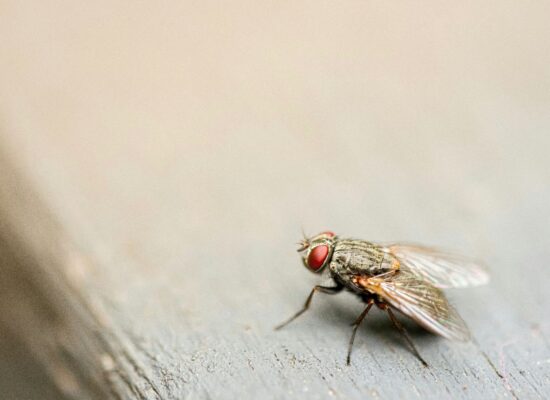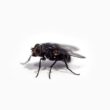Flies are amazing at making more flies. They can go from tiny eggs to full-grown adults in just a few weeks. This happens so quickly that you might clean your kitchen one day and find maggots the next.
The fly life cycle has four parts: egg, larva (that’s the maggot), pupa, and adult fly. The best time to stop flies is right at the beginning when they’re still eggs. Once they turn into maggots, things get much harder to control.
What Do Fly Eggs Look Like and Where Are They Found
Most people have never actually seen fly eggs because they’re so tiny and well hidden. Learning what to look for can help you catch problems early.
Spotting Fly Eggs Before They Hatch
Fly eggs are really small and easy to miss. Most people don’t notice them until it’s too late. Here’s what to look for:
- Size: About as big as a grain of sand
- Color: White or pale yellow
- Shape: Like tiny rice grains
- Where they cluster: Usually in groups of 50 to 150 eggs
- Texture: Soft and a bit see-through
The Scary 24 Hour Timeline
Here’s the part that catches most people off guard. Fly eggs can hatch in just 8 to 12 hours when it’s warm and humid. Even in cooler weather, you’re looking at about 24 hours. That means yesterday’s clean garbage can could be today’s maggot factory.
Temperature makes a huge difference:
- Hot weather (80°F and up): Eggs hatch in 8 to 12 hours
- Normal weather (70 to 75°F): Takes about 1 to 2 days
- Cool weather (under 65°F): Development slows way down
Where Different Types of Flies Like to Lay Eggs
Not all flies are the same. Each type has favorite spots for laying their eggs.
Knowing which fly you’re dealing with helps you target the right areas for cleanup and prevention.
House Flies Love Gross Stuff
- Where they lay eggs: Trash cans, dog poop, rotting food
- How many eggs: Up to 500 per female fly
- What they need: Wet, rotting stuff that’s warm
- When they’re worst: Late spring through fall
Fruit Flies Target Your Kitchen
- Where they lay eggs: Overripe bananas, dirty drains, spilled juice
- How many eggs: About 400 to 500 per female
- What they need: Sweet, fermenting stuff
- Problem time: All year, especially in winter when windows stay closed
Drain Flies Live in Your Pipes
- Where they lay eggs: Bathroom drains, wet basements, air conditioning drips
- How many eggs: 30 to 100 per female
- What they need: Standing water with gunk buildup
- How to spot them: They look fuzzy and fly like tiny moths
Blow Flies Go for Dead Things
- Where they lay eggs: Dead animals, spoiled meat, pet accidents
- How many eggs: 150 to 200 at once
- What they need: Rotting protein
- Speed: Can go from egg to adult in just 10 to 14 days
Why Flies Are More Than Just Annoying
Sure, flies buzzing around your head is irritating. But there’s a bigger problem. Flies that come from gross breeding spots carry germs on their bodies and in their stomachs.
Diseases Flies Can Spread
- Stomach bugs: Salmonella, E. coli, food poisoning bacteria
- Viruses: Stomach flu and other intestinal viruses
- Parasites: Tiny organisms that cause diarrhea
- Food contamination: They land on your food after walking through garbage
Who’s Most at Risk
Kids, elderly people, and anyone with health problems face the biggest risks from fly germs. That’s why stopping fly eggs before they hatch is so important for these families.
How to Get Rid of Fly Eggs Right Away
You need to play detective and check these common spots. Acting fast is the key to stopping a bigger problem from developing.
Step One: Find Where They’re Coming From
You need to play detective and check these common spots:
- Kitchen trash and recycling bins
- Pet food bowls and litter boxes
- All the drains in your house
- Damp basement corners
- Compost bins and garden areas
Step Two: Clean Everything Out
- Use a wet vacuum to suck up any eggs or maggots you see
- Throw away the vacuum bag immediately in a sealed trash bag
- Scrub the area with hot soapy water
- Spray disinfectant to kill leftover germs
Step Three: Make the Area Unfriendly to Flies
- Use fans or dehumidifiers to dry things out
- Fix leaky pipes and improve air flow
- Seal up cracks where flies might get in
- Make sure water drains away properly
Advanced Ways to Stop Fly Problems
Sometimes basic cleaning isn’t enough to solve stubborn fly issues. These methods can help when regular approaches aren’t working.
Natural Solutions That Work
Helpful Bugs Some tiny worms and mites actually eat fly larvae. You can buy these at garden stores and use them in compost piles or soil.
Bacterial Treatments Special bacteria that only hurt fly larvae can be added to standing water like bird baths or rain barrels.
Physical Blocks Fine mesh screens keep adult flies from getting in to lay eggs. The mesh needs to be really fine to work well.
Chemical Options
Growth Stoppers These products mess up the fly development process so eggs can’t turn into adults.
Surface Sprays Long lasting sprays can be applied to areas where adult flies like to land.
Drain Treatments Special gels made for drains can kill fly eggs and larvae living in the pipes.
Creating a Long Term Plan to Keep Flies Away
Getting rid of current flies is just the first step. Building good habits keeps them from coming back in the future.
Daily Habits That Help
Every Day Tasks
- Empty trash cans and wipe them clean
- Clean up food crumbs and spills right away
- Check for wet spots and dry them up
- Clean up pet waste immediately
Weekly Jobs
- Pour enzyme cleaner down all drains
- Clean out garbage disposals thoroughly
- Check basement and crawl spaces for moisture
- Keep compost bins properly maintained
Monthly Check Ups
- Have drains professionally cleaned if needed
- Inspect air conditioning for water problems
- Walk around outside looking for dead animals
- Review what’s working and what isn’t
Making Your Home Fly Proof
Control Moisture Keeping humidity under 50% makes it much harder for fly eggs to develop. Use dehumidifiers and fix water leaks quickly.
Stay Super Clean Clean like you’re running a restaurant, even at home. This means deep cleaning areas that might have hidden organic stuff.
Keep Flies Out Focus on stopping adult flies from getting in rather than fighting them after they’re already inside. Good screens and sealed entry points work better than trying to kill flies later.
When You Need Professional Help
Sometimes DIY methods just aren’t enough to handle a serious fly problem. Here’s how to know when it’s time to call in the experts.
Signs It’s Time to Call Experts
- Flies keep coming back even after thorough cleaning
- Finding lots of maggots in multiple areas
- Different types of flies showing up at the same time
- Someone in the house has health problems
- Running a business or restaurant
What Professionals Bring
Pest control experts have stronger products and special equipment that regular people can’t buy. They also know how to use integrated approaches that work better than trying one thing at a time.
New Technology for Fighting Flies
The pest control world keeps getting better tools and methods. Some of these newer options might be helpful for tough situations.
Smart Monitoring
- Traps that send alerts to your phone
- Apps that predict when fly problems might start
- Digital counters that track how many flies are caught
Future Solutions
Scientists are working on new ways to control flies using light patterns, genetic methods, and better biological controls.
Stop Problems Before They Start
The best way to deal with flies is to never let them get established in the first place. Understanding how fast fly eggs develop and taking action right away makes all the difference.
Fly control isn’t something you do once and forget about. It takes ongoing attention and consistency. But the effort pays off in a more comfortable, healthier home.
When fly problems persist despite your best efforts, professional pest control services can provide the expertise and tools needed for complete elimination.


